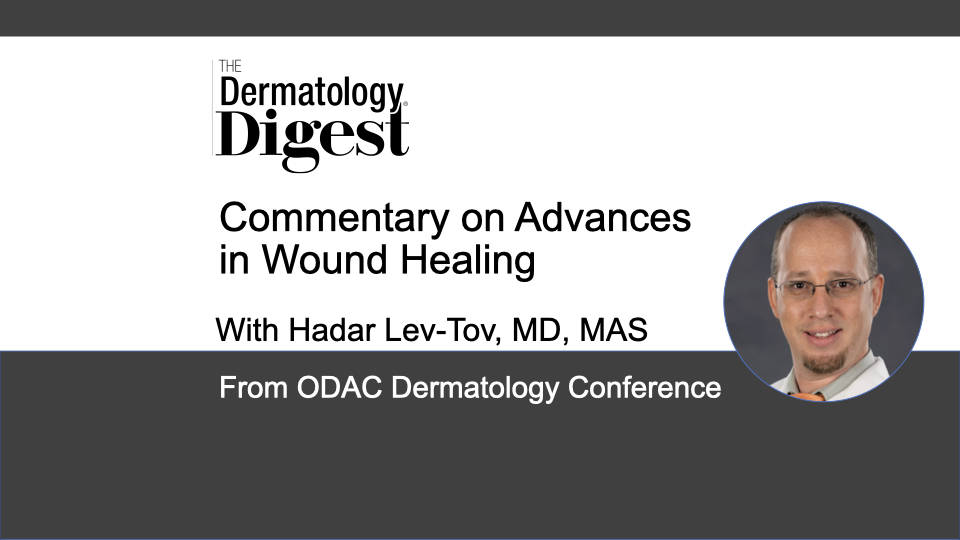Dr. Hadar Lev-Tov discusses wound healing innovations, including topical timolol and a bioelectric dressing technology.
Hadar Lev-Tov, MD, MAS, Associate Professor, Department of Dermatology, University of Miami, Miller School of Medicine
“It’s a really exciting time in wound healing and if you’re a dermatologist, I think you really would love this because wound healing has a lot to do with the skin and who knows better about skin than dermatologists, right?” said Hadar Lev-Tov, MD, MAS, who presented “Advances in Wound Healing” at this year’s ODAC Dermatology Conference.
“So even though as a field sometimes we think this is not part of what we do, in fact, we are the most qualified to handle these issues.”
According to Dr. Lev-Tov, there are a couple of stand-out innovations, including topical timolol and a bioelectric dressing technology.
Topical Timolol
“One of the things is the use of timolol, a beta blocker, to help heal wounds. Now, this is a result of a work that started in the lab of one of my mentors, Dr. Rivka Isseroff, at the University of California, Davis.”
Although Dr. Isseroff is a dermatologist, she also does basic science and clinical medicine, said Dr. Lev-Tov.
“Some of the folks in her lab realized that when you block these receptors in keratinocytes and fibroblasts, you really get improved healing. Well, that’s nice in the test tube, but honestly, we treat patients, and we want to know what’s happening in human wounds.”
As a result, Dr. Lev-Tov and the University of Miami teamed up with researchers at UC Davis to examine a group of patients with variety of wounds, he said.
“And what we found substantiates what we know already in vitro and what we know in certain case reports—that using topical timolol, about one drop per centimeter square, can help to improve healing.”
Important to note, however, is that timolol takes time to heal and best used as a secondary agent, said Dr. Lev-Tov.
“So these were wounds that maybe already failed first line therapy or did not respond as adequately as we wanted to and so this was added as a secondary agent. And even with that it took an average of about 90 days to heal.”
A plus, once-a-day dosing is sufficient and practical for wound healing, said Dr. Lev-Tov.
“… this is important because some of the wounds, as you know, are covered with dressing and so it’s not like putting a cream over psoriasis, for example, where the lesion is exposed.”
Although using timolol is off-label use, it showed benefit in a large number of patients, and it’s been used for many years, so we know it’s relatively safe and affordable, said Dr. Lev-Tov.
“So that was very exciting to us…”
Restoring the Electrical Field
The second innovation involves restoring the electrical field around a wound to promote healing, said Dr. Lev-Tov.
“…you are a walking battery, so your skin has potential. And when you create a wound in the skin, you disrupt that potential and so electrons start flowing and you get this current that is happening. And [it] turns out that if you can correct the potential, you can actually heal the wound faster.”
Conceptually, this has been known for years, said Dr. Lev-Tov. However, the challenge that pioneers Oscar Alvarez and Bill Eaglestein at the University of Miami initially faced was the size of the device needed to recharge the skin.
“In their experiments, they used pigs and they had to tie a huge battery to their body, and you can imagine that no patient wants to walk around with a large power source on their body.”
In more recent years, Vomaris Innovations, Inc. has developed a bioelectric technology in a wound dressing with a zinc and silver ion matrix that generates an electrical field to support the healing process, said Dr. Lev-Tov. Not only does this offer a more practical power source but it also inspired additional application.
“I take care of a lot of patients with hidradenitis suppurativa (HS), which is a devastating disease. And so what we thought is, hey, what does this actually do to the inflammatory response?”
According to Dr. Lev-Tov, his team conducted a literature review and discovered that the dressing affects interleukin-1beta and tumor necrosis factor-⍺, both of which are implicated in the pathogenesis of HS. It also has a potent antimicrobial effect, he said.
“…now we’re running a study with people who undergo deroofing in both armpits. …so after the surgery they receive the electric dressing, or we call it the bioelectric dressing in one armpit, and then on the other side, they get standard of care. And we already see some signal of improved healing.”
The skin definitely looks different, he said.
“One of the things we are curious to see is if this will result in less recurrence.”
Results of the randomized trial are about a year out, said Dr. Lev-Tov, but the team has anecdotally observed no recurrence vs mild recurrence in the treatment versus standard of care areas.
“What is it going to do to the rate of healing? We’re not sure that still wait for the final data. But definitely it’s a cool electrifying time in dermatology and wound healing.”
For anyone who decides to give the bioelectric dressing a go, Dr. Lev-Tov offers this advice:
“Remember, look at the instructions on how to use it. It’s a primary dressing. And so you may want to have a secondary absorptive dressing and all that stuff that you know about how to heal a wound, but certainly I welcome people to try and see if that if that is electrifying to them as it was to me.”
Disclosure: Dr. Lev-Tov received a research grant from Vomaris.


